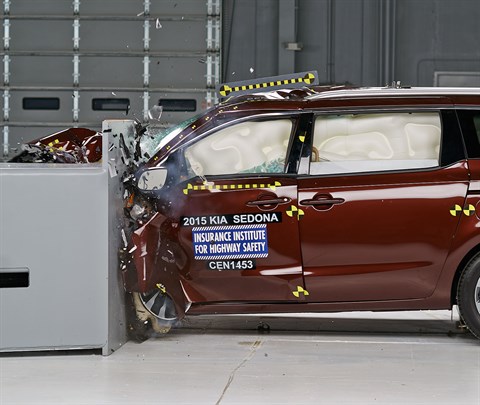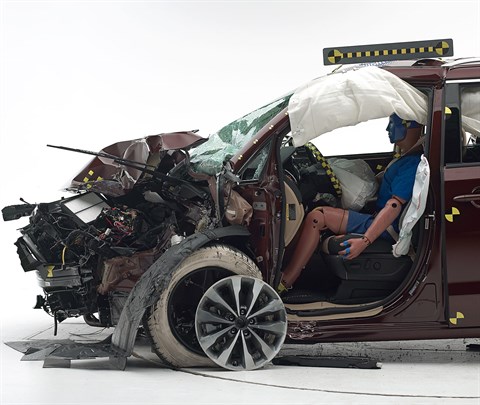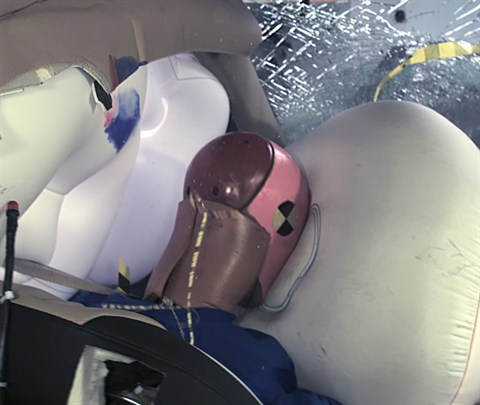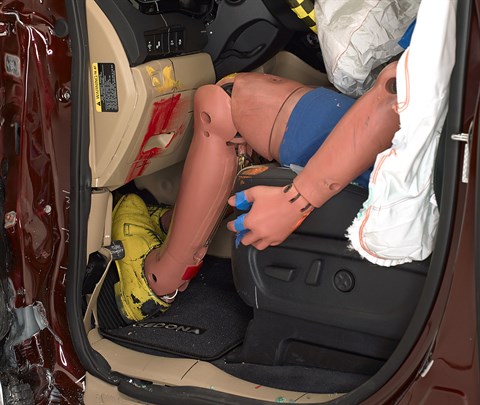Small overlap front: driver-side
Rating applies to 2015-21 models
Tested vehicle: 2015 Kia Sedona SX
The Kia Sedona was redesigned for the 2015 model year. Two tests of the Sedona were conducted. In the first test, the unlocked driver door opened, which shouldn't happen because the driver could be partly or completely ejected from the vehicle. Also, intrusion into the occupant compartment was exacerbated by the door not remaining in place to help absorb crash forces.
In response, Kia reprogrammed the standard autolock feature, which locks all doors when the vehicle is placed in forward or reverse gear, to prevent consumers from disabling this feature, beginning with 2015 models built after November 2014. In addition, Kia started a service campaign to similarly reprogram the autolock feature on 2015 models built earlier.
In the second test with locked doors, the driver door stayed shut, and intrusion was significantly reduced. Ratings of the Sedona are based on the second test.
| Overall evaluation | |
|---|---|
| Structure and safety cage | |
| Driver injury measures | |
| Head/neck | |
| Chest | |
| Hip/thigh | |
| Lower leg/foot | |
| Driver restraints and dummy kinematics |

Action shot taken during the second of two small overlap frontal crash tests.

The dummy's position in relation to the door frame, steering wheel, and instrument panel after the second crash test indicates that the driver's survival space was maintained reasonably well.

The frontal and side curtain airbags worked well together in the second crash test to keep the head from coming close to any stiff structure or outside objects that could cause injury.

Intrusion into the driver's space was reasonably well controlled in the second test, and risk of injuries to the dummy's legs and feet was low.
Measures of occupant compartment intrusion on driver side
| Test ID | CEN1453 |
|---|---|
| Lower occupant compartment | |
| Lower hinge pillar max (cm) | 11 |
| Footrest (cm) | 10 |
| Left toepan (cm) | 6 |
| Brake pedal (cm) | 3 |
| Parking brake (cm) | 12 |
| Rocker panel lateral average (cm) | 2 |
| Upper occupant compartment | |
| Steering column | 2 |
| Upper hinge pillar max (cm) | 12 |
| Upper dash (cm) | 10 |
| Lower instrument panel (cm) | 8 |
Driver injury measures
| Test ID | CEN1453 |
|---|---|
| Head | |
| HIC-15 | 102 |
| Peak gs at hard contact | no contact |
| Neck | |
| Tension (kN) | 1.0 |
| Extension bending moment (Nm) | 10 |
| Maximum Nij | 0.19 |
| Chest maximum compression (mm) | 25 |
| Femur (kN) | |
| Left | 3.1 |
| Right | 0.2 |
| Knee displacement (mm) | |
| Left | 8 |
| Right | 3 |
| Knee-thigh-hip injury risk (%) | |
| Left | 1 |
| Right | 0 |
| Maximum tibia index | |
| Left | 0.53 |
| Right | 0.46 |
| Tibia axial force (kN) | |
| Left | 1.3 |
| Right | 0.2 |
| Foot acceleration (g) | |
| Left | 47 |
| Right | 54 |
Moderate overlap front: original test
Rating applies to 2015-21 models
Tested vehicle: 2015 Kia Sedona SX Limited
The Kia Sedona was redesigned for the 2015 model year. Moderate overlap frontal ratings are assigned by the Institute based on a test conducted by Hyundai/Kia as part of frontal crash test verification.
| Overall evaluation | |
|---|---|
| Structure and safety cage | |
| Driver injury measures | |
| Head/neck | |
| Chest | |
| Leg/foot, left | |
| Leg/foot, right | |
| Driver restraints and dummy kinematics |
Measures of occupant compartment intrusion on driver side
| Test ID | VTF1409 |
|---|---|
| Footwell intrusion | |
| Footrest (cm) | 4 |
| Left (cm) | 8 |
| Center (cm) | 8 |
| Right (cm) | 8 |
| Brake pedal (cm) | 12 |
| Instrument panel rearward movement | |
| Left (cm) | 1 |
| Right (cm) | 2 |
| Steering column movement | |
| Upward (cm) | -5 |
| Rearward (cm) | -6 |
| A-pillar rearward movement (cm) | 0 |
Driver injury measures
| Test ID | VTF1409 |
|---|---|
| Head | |
| HIC-15 | 207 |
| Peak gs at hard contact | no contact |
| Neck | |
| Tension (kN) | 1.5 |
| Extension bending moment (Nm) | 19 |
| Maximum Nij | 0.32 |
| Chest maximum compression (mm) | 30 |
| Legs | |
| Femur force - left (kN) | 1.1 |
| Femur force - right (kN) | 0.0 |
| Knee displacement - left (mm) | 1 |
| Knee displacement - right (mm) | 0 |
| Maximum tibia index - left | 0.28 |
| Maximum tibia index - right | 0.31 |
| Tibia axial force - left (kN) | 1.4 |
| Tibia axial force - right (kN) | 0.7 |
| Foot acceleration (g) | |
| Left | 36 |
| Right | 72 |
Side: original test
Rating applies to 2015-21 models
Tested vehicle: 2015 Kia Sedona EX or SX with standard head curtain airbags for all three rows of seats and standard front seat-mounted torso airbags
The Kia Sedona was redesigned for the 2015 model year. Side ratings are assigned by the Institute based on a test conducted by Hyundai/Kia as part of side crash test verification.
| Overall evaluation | |
|---|---|
| Structure and safety cage | |
| Driver injury measures | |
| Head/neck | |
| Torso | |
| Pelvis/leg | |
| Driver head protection | |
| Rear passenger injury measures | |
| Head/neck | |
| Torso | |
| Pelvis/leg | |
| Rear passenger head protection | |
Measures of occupant compartment intrusion on driver side
| Test ID | VTS1409 |
|---|---|
| B-pillar to longitudinal centerline of driver's seat (cm) | -14.5 |
| Negative numbers indicate the amount by which the crush stopped short of the seat centerline. | |
Driver injury measures
| Test ID | VTS1409 |
|---|---|
| Head HIC-15 | 118 |
| Neck | |
| Tension (kN) | 0.6 |
| Compression (kN) | 0.9 |
| Shoulder | |
| Lateral deflection (mm) | 20 |
| Lateral force (kN) | 1.0 |
| Torso | |
| Maximum deflection (mm) | 28 |
| Average deflection (mm) | 26 |
| Maximum deflection rate (m/s) | 3.95 |
| Maximum viscous criterion (m/s) | 0.40 |
| Pelvis | |
| Iliac force (kN) | 1.9 |
| Acetabulum force (kN) | 1.3 |
| Combined force (kN) | 3.2 |
| Left femur | |
| L-M force (kN) | 0.6 |
| L-M moment (Nm) | 100 |
| A-P moment (Nm) | 18 |
Passenger injury measures
| Test ID | VTS1409 |
|---|---|
| Head HIC-15 | 101 |
| Neck | |
| Tension (kN) | 0.2 |
| Compression (kN) | 0.4 |
| Shoulder | |
| Lateral deflection (mm) | 22 |
| Lateral force (kN) | 1.3 |
| Torso | |
| Maximum deflection (mm) | 27 |
| Average deflection (mm) | 21 |
| Maximum deflection rate (m/s) | 2.67 |
| Maximum viscous criterion (m/s) | 0.30 |
| Pelvis | |
| Iliac force (kN) | 0.4 |
| Acetabulum force (kN) | 1.6 |
| Combined force (kN) | 1.8 |
| Left femur | |
| L-M force (kN) | 0.6 |
| L-M moment (Nm) | 95 |
| A-P moment (Nm) | 25 |
Roof strength
Rating applies to 2015-21 models
Tested vehicle: 2015 Kia Sedona SX
| Overall evaluation | |
|---|---|
| Curb weight | 4,583 lbs |
| Peak force | 22,074 lbs |
| Strength-to-weight ratio | 4.82 |
Head restraints & seats
Seat type: Power leather seat
| Overall evaluation | |
|---|---|
| Dynamic rating | |
| Seat/head restraint geometry |
| Seat type | Power leather seat |
|---|---|
| Geometry | |
| Backset (mm) | 8 |
| Distance below top of head (mm) | 19 |
| Seat design parameters | |
| Pass/fail | Pass |
| Max T1 acceleration (g) | 12.2 |
| Head contact time (ms) | 54 |
| Force rating | 1 |
| Neck forces | |
| Max neck shear force (N) | 0 |
| Max neck tension (N) | 318 |
How the head restraint & seat test is conducted
Currently, IIHS tests apply only to front seats.
Front crash prevention: vehicle-to-vehicle
Child seat anchors
Rating applies to 2015-21 models
| Overall evaluation |
|
| Vehicle trim | LX |
| Seat type | cloth |
This vehicle has 3 rear seating positions with complete child seat attachment (LATCH) hardware.
It has 1 additional seating position with a tether anchor only.
| Overall evaluation |
|
| Vehicle trim | LX |
| Seat type | cloth |
| G | Good |
| A | Acceptable |
| M | Marginal |
| P | Poor |
|
|
Seating positions that rely on borrowed lower anchors or have only a tether anchor available are not rated. |
|
thether anchor symbol
|
Tether anchor |
|
lower anchor symbol
|
Lower anchors |
| Lower anchor(s) can be borrowed from adjacent positions(s) | |
|
|
No hardware available |
Details by seating position
| 1 | |
|---|---|
| Tether anchor | |
| hard-to-find location | |
| no other hardware could be confused for anchor | |
| Lower anchors | |
| not too deep in seat | |
| not too much force needed to attach | |
| easy to maneuver around anchors | |
| 3 | |
| Tether anchor | |
| hard-to-find location | |
| no other hardware could be confused for anchor | |
| Lower anchors | |
| not too deep in seat | |
| not too much force needed to attach | |
| easy to maneuver around anchors | |
| 4 | |
| Tether anchor | |
| hard-to-find location | |
| no other hardware could be confused for anchor | |
| Lower anchors | |
| not too deep in seat | |
| not too much force needed to attach | |
| easy to maneuver around anchors | |
| 5 | |
| Tether anchor | |
| hard-to-find location | |
| no other hardware could be confused for anchor | |
| Lower anchors | |
| none available |
Seat position 21
| Lower anchor A | |
|---|---|
| Open access rated | No |
| Depth (cm) | 0-2 |
| Force (lbs) | 8 |
| Clearance angle (degrees) | 65 |
| Lower anchor B | |
| Open access rated | No |
| Depth (cm) | 0-2 |
| Force (lbs) | 9 |
| Clearance angle (degrees) | 67 |
| Tether anchor | |
| Location | Bottom seatback |
| Confusing hardware present | No |
| Has contrasting label within 3 inches of tether anchor |
No |
Seat position 23
| Lower anchor A | |
|---|---|
| Open access rated | No |
| Depth (cm) | 0-2 |
| Force (lbs) | 12 |
| Clearance angle (degrees) | 61 |
| Lower anchor B | |
| Open access rated | No |
| Depth (cm) | 0-2 |
| Force (lbs) | 20 |
| Clearance angle (degrees) | 61 |
| Tether anchor | |
| Location | Bottom seatback |
| Confusing hardware present | No |
| Has contrasting label within 3 inches of tether anchor |
No |
Seat position 32
| Lower anchor A | |
|---|---|
| No lower latch for this seat position | |
| Lower anchor B | |
| No lower latch for this seat position | |
| Tether anchor | |
| Location | Bottom seatback |
| Confusing hardware present | No |
| Has contrasting label within 3 inches of tether anchor |
No |
Seat position 33
| Lower anchor A | |
|---|---|
| Open access rated | No |
| Depth (cm) | 0-2 |
| Force (lbs) | 14 |
| Clearance angle (degrees) | 72 |
| Lower anchor B | |
| Open access rated | No |
| Depth (cm) | 0-2 |
| Force (lbs) | 14 |
| Clearance angle (degrees) | 74 |
| Tether anchor | |
| Location | Bottom seatback |
| Confusing hardware present | No |
| Has contrasting label within 3 inches of tether anchor |
No |
